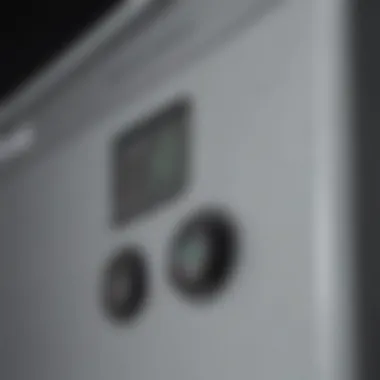Optimal Settings for Dehumidifiers: A Comprehensive Guide


Intro
Dehumidifiers play a crucial role in creating a comfortable indoor environment. They help reduce excess moisture, which can cause discomfort and damage to the home. This article aims to provide homeowners and design enthusiasts with essential information on dehumidifier settings tailored to different spaces, humidity levels, and seasonal variations. Understanding these factors can enhance living conditions and promote better health.
The relevance of this topic cannot be overstated. Maintaining optimal humidity levels contributes to the overall comfort of your home, impacts indoor air quality, and can even protect your belongings from mold and mildew. In essence, knowing how to properly set and use a dehumidifier is key to achieving an ideal indoor climate.
Optimal Humidity Levels
Ideal Humidity Ranges
Maintaining the right humidity in your home is essential. Generally, the recommended indoor humidity level should be between 30% and 50%. This range reduces the risk of mold growth and creates a more pleasant atmosphere.
Impact of Seasonal Changes
Seasonal variations also affect ideal humidity settings. During summer months, outdoor humidity levels tend to be higher, which can seep indoors. In winter, the air is dryer, often requiring less dehumidification. Being mindful of these shifts will ensure efficiency.
Tips for Monitoring Humidity
To accurately monitor indoor humidity:
- Invest in a hygrometer.
- Check the levels regularly, especially during seasonal changes.
- Adjust your dehumidifier settings accordingly.
Design Considerations
While the aesthetic of your dehumidifier might not be a primary concern, these units can still be integrated into your home design. Consider the following:
Size and Placement
Choosing the right size dehumidifier is crucial.
- Large rooms need larger units for efficiency.
- Place the dehumidifier in areas that usually accumulate humidity, like basements or bathrooms.
Noise Levels
Dehumidifiers can generate noise. Look for models that specify quiet operation if noise is a concern in your living space.
Maintenance and Upkeep
Like any appliance, dehumidifiers require regular maintenance to function effectively.
Seasonal Maintenance Checklist
It’s advisable to perform maintenance checks seasonally:
- Clean or replace filters regularly.
- Inspect the water reservoir for algae or mold.
- Check hoses for clogs or leaks.
Cleaning and Organization Tips
- Keep the area around the dehumidifier clear.
- Wipe down the unit periodically to prevent buildup of dust and debris.
- Store the unit properly during off-seasons to avoid damage.
"A well-maintained dehumidifier can last up to 10 years, significantly improving your indoor climate."
Culmination
Selecting optimal settings for dehumidifiers is not merely a technical task; it's a step toward creating a healthier living environment. By understanding humidity levels, room size, and maintenance needs, homeowners can effectively manage their indoor climate. This guide illustrates that informed decisions greatly enhance comfort and well-being at home.
Understanding Dehumidifiers
Dehumidifiers play a crucial role in controlling indoor humidity levels. Proper humidity management can significantly affect comfort, health, and overall quality of indoor living spaces. A well-maintained humidity level not only ensures comfort but also prevents damage to property and belongings. For example, too much moisture can lead to mold growth and structure damage, making it essential to understand how dehumidifiers function and their different types.
Definition and Function
A dehumidifier is a device designed to reduce and maintain the level of humidity in the air. It works by drawing in humid air and removing excess moisture through a condensation process. This process contributes to creating a comfortable indoor climate. By maintaining optimal humidity levels, dehumidifiers can help in the prevention of mold and mildew, which can be detrimental to both health and property.
Types of Dehumidifiers


Different environments require varying solutions for humidity control. Hence, it is important to understand the types of dehumidifiers available and their functions.
Refrigerant Dehumidifiers
Refrigerant dehumidifiers operate using a cooling coil system. When humid air passes over the cold coils, moisture condenses and collects in a reservoir, while drier air is released back into the room. This type is particularly effective in warmer conditions because it can lower the air temperature as it removes humidity. They are popular in residential settings because of their efficiency in normal humidity levels.
However, in very low temperatures, their effectiveness diminishes, making them less suitable for those conditions.
Desiccant Dehumidifiers
Desiccant dehumidifiers differ from refrigerant types as they use a hygroscopic material to absorb moisture from the air. They work well in lower humidity settings and are often quieter than mechanical alternatives. The primary advantage is their capability to function efficiently in cold environments.
Despite their effectiveness, desiccant technologies can consume more energy during operation, especially when drying large spaces.
Thermoelectric Dehumidifiers
Thermoelectric dehumidifiers utilize a thermoelectric cooling system, which has no moving parts, making them silent and energy-efficient. They are compact and effective for smaller spaces or for personal use. Their design allows for easy portability, which is beneficial for specific applications like closets or small rooms.
However, they typically have a lower moisture removal capacity compared to refrigerant and desiccant models, making them less ideal for larger or more humid areas.
Understanding these various types allows homeowners and design enthusiasts to choose the right dehumidifier based on their specific needs. They can consider factors such as room size, humidity levels, and seasonal variations that may influence the optimal choice.
Importance of Setting Adjustments
Adjusting the settings on a dehumidifier is critical for optimal performance. This process goes beyond simply turning the device on or off. It directly influences comfort, health, and energy efficiency within your space. Proper settings ensure that the dehumidifier operates at a level that suits the specific conditions of your environment. Ignoring the need for adjustments may result in excessive humidity or dryness, both of which can have negative consequences.
Finding the Right Humidity Level
Setting the correct humidity level is essential for maintaining a comfortable indoor environment. The ideal relative humidity typically ranges from 30% to 50%. This range promotes comfort and prevents the growth of mold and mildew.
Recommended Relative Humidity Levels
Recommended relative humidity levels play a pivotal role in home comfort and health. Staying within 30% to 50% supports a balanced atmosphere that feels pleasant. Areas with high humidity can lead to discomfort, while low humidity can cause dry skin and respiratory issues. This 30-50% range is recommended by various health organizations for its beneficial effects on both humans and indoor materials. Thus, it helps maintain both comfort and structural integrity in a home.
Effects of Improper Humidity
Improper humidity can have many negative effects. High humidity levels lead to condensation, which can damage walls and personal items. Conversely, low humidity can cause skin irritations and respiratory problems. Being aware of these consequences is important when selecting the right humidity level. When people do not monitor humidity properly, they may encounter increased complaints of allergies and issues with dust and other irritants.
Impact on Indoor Air Quality
Setting the correct humidity also has significant implications for indoor air quality. This factor is crucial for overall well-being and comfort in living spaces.
Mold and Mildew Prevention
Preventing mold and mildew is a top priority for maintaining air quality. Excess moisture in the air creates an environment conducive to mold growth. Setting dehumidifiers to prevent excess humidity directly affects mold prevention strategies. It is essential to select appropriate levels that discourage mold growth in specific areas, such as basements or bathrooms. As a result, the air remains cleaner and healthier for occupants.
Respiratory Health Considerations
Respiratory health is closely tied to humidity levels as well. High humidity can trigger respiratory discomfort, especially in individuals with existing conditions, like asthma. In contrast, very dry air can irritate the airways. Adjusting the humidity level can help reduce these irritations. By maintaining a balanced humidity level, users can contribute positively to their indoor air quality. This consideration is important not only for personal comfort but also for health, especially for vulnerable individuals.
Assessing Current Humidity Levels
Assessing humidity levels is crucial for maintaining an optimal indoor environment. Knowing the precise humidity level helps determine effective settings for dehumidifiers, ensuring they work efficiently. High humidity can lead to discomfort, increased energy costs, and potential mold growth, while low humidity can cause dryness in the air, affecting health and comfort. Therefore, understanding how to measure humidity is fundamental.
Using Humidity Monitors
Digital Hygrometers
Digital hygrometers are electronic instruments that provide precise readings of humidity levels. Their key characteristic is their accuracy and ease of use. Many models also come with features such as temperature measurement and memory functions for tracking historical data. Digital hygrometers are a beneficial choice as they allow for real-time monitoring, giving users the ability to make quick adjustments to their dehumidification settings.
A unique feature of digital hygrometers is their digital display, which offers clear visibility. However, they require power, which can limit their placement options in some areas. The advantage of their precision outweighs any minor difficulties in usage.
Analog Hygrometers
Analog hygrometers function through mechanical means, using a dial and a needle to indicate humidity levels. Their key characteristic is their simplicity and reliability without the need for batteries. Many find them appealing due to their classic design, making them a popular choice in home decor.


One unique feature of analog hygrometers is their durability; they can last for years with minimal maintenance. However, they can be less accurate than digital models, especially in extreme conditions. Despite this, their appeal lies in their straightforward, no-frills approach to measuring humidity.
Factors Affecting Humidity Levels
Geographic Location
Geographic location significantly influences indoor humidity levels. Different areas have unique climates that affect both outdoor and indoor environments. For instance, coastal regions usually experience higher humidity, while arid areas maintain lower moisture levels. Understanding one’s geographic location assists in adjusting settings for dehumidifiers effectively.
The benefit of recognizing this aspect is in tailoring the humidity control strategy based on common regional trends. It assists users in seting realistic expectations for indoor climate control throughout the year. However, it is essential to note that local microclimates may also play a role, so adjustments might be necessary even among close locations.
Seasonal Changes
Seasonal changes also play a pivotal role in indoor humidity levels. For example, summer often brings higher humidity than winter, leading to different operational needs for dehumidifiers. Recognizing these seasonal changes is important for maintaining comfort year-round.
One notable aspect of seasonal changes is the need for varied settings in different months. During summer, higher humidity levels may require lower settings for dehumidifiers to maintain comfort. Conversely, winter might see reduced humidity, where settings may not require as much adjustment. Understanding these changes can guide users in effectively managing their indoor environment.
Recommended Settings for Different Environments
Understanding the recommended settings for dehumidifiers in various environments is crucial for optimizing performance. Each space, whether residential or commercial, has unique humidity needs dictated by usage, layout, and external factors. By tailoring the settings to specific surroundings, you can enhance comfort and health while also ensuring the efficient operation of your dehumidifier. Proper settings prevent mold growth, protect furnishings, and create favorable indoor climates.
Residential Spaces
Bedrooms
In bedrooms, it's essential to maintain a relative humidity of around 30-50%. This level supports comfort and optimal sleep quality. High humidity can lead to a damp feeling, while low humidity may result in dry skin and respiratory irritations. The bedroom’s unique feature is its close environment where personal comfort affects well-being. Choosing a dehumidifier with a quiet function is beneficial, especially during the night.
Living Rooms
Living rooms usually serve as the central gathering place of the home. Ideal humidity levels here range from 40-60%. This tells us that a dehumidifier not only regulates moisture but also contributes to a relaxing atmosphere. One key characteristic of living rooms is their larger size, which may require a more powerful unit. However, over-drying can lead to static electricity and discomfort. Thus, balancing moisture levels is important.
Basements
Basements generally have higher humidity due to their underground location, leading to issues such as mold and mildew. The recommended humidity level is below 50%, which can significantly reduce mold growth and improve air quality. The unique feature of basements is the potential for dampness and odor, which can make areas uninhabitable. A consistent dehumidification strategy can help maintain a safe and clean environment, making basements more usable spaces.
Commercial Spaces
Offices
In office settings, maintaining a humidity level between 40-60% aids in both productivity and comfort. High humidity can lead to decreased efficiency, discomfort, and even issues with equipment. The design of office spaces often includes windows and ventilations, adding to the complexity of humidity management. A properly calibrated dehumidifier can make a significant difference in employee well-being by preventing mold growth and ensuring clean air circulation.
Warehouses
Warehouses often have fluctuating humidity levels due to product storage and loading activities. Setting dehumidifiers to maintain 45-55% humidity can protect goods, especially if sensitive materials are involved. The large volume of air in warehouses requires a dehumidifier with a higher capacity. An important factor is the potential for condensation, which can lead to spoilage or damage. Effective settings help secure goods from moisture detriment.
Retail Stores
Retail environments benefit from humidity levels maintained between 40-50%. This range not only helps in protecting products but also creates a pleasant shopping experience. The atmosphere of a store can influence purchasing decisions, thus regulating humidity can enhance overall customer satisfaction. However, over-dehumidification can lead to discomfort for shoppers. Striking a balance in settings is key for both product and customer comfort.
"The right humidity levels in different environments play a critical role in not only maintaining comfort but also protecting health and property."
By understanding the specific humidity requirements of different environments, you can effectively configure and maximize the benefits of your dehumidifier.
Adjusting Settings According to Seasons
Adjusting settings on a dehumidifier according to the seasons is vital for achieving optimal indoor air quality and comfort. Different weather patterns lead to varying humidity levels, which directly influence how a space feels and functions. As seasons change, so do the demands placed on your dehumidifier. This section will delve into why seasonal adjustments matter, focusing on their benefits, key considerations, and practical tips for homeowners.
A dehumidifier serves as a crucial tool to maintain humidity within a desired range. During high humidity months in summer, a dehumidifier works hard to eliminate excess moisture. However, as the chilly winter months set in, changes in indoor heating can create conditions where humidity levels might drop too low. Understanding when and how to adjust settings based on these external factors is key to sustaining a comfortable living environment while preserving the dehumidifier's efficient operation.
Summer Settings
In the summer, humidity levels tend to spike, which can lead to discomfort and potentially harmful growth of mold and mildew. Thus, adjusting the dehumidifier to tackle these higher levels of moisture is paramount.
- Optimal Humidity Levels: Aim for maintaining a relative humidity between 30 to 50 percent during the summer months. This range helps prevent discomfort while ensuring that your home feels cool and refreshing.
- Increased Frequency: Set the dehumidifier to run more frequently or continuously, especially during humid days. This proactive approach can help in actively removing moisture and improving air quality.
- Door and Window Checks: Keep doors and windows closed as much as possible. Outside humidity can enter, making it harder for the unit to maintain set levels.
It is important to regularly empty the water reservoir or ensure that drainage is functioning properly, as high moisture levels will lead to rapid filling.


Winter Settings
Winter brings its own challenges with humidity levels potentially dropping too low, particularly due to heating systems running consistently. This can cause dry air, which may lead to various issues, including respiratory problems and discomfort.
- Adjusting Humidity Goals: In winter, aim for maintaining a relative humidity of around 30 to 40 percent. This level helps keep skin and sinuses from drying out while minimizing static electricity.
- Monitor Indoor Sources of Moisture: Cooking and showering can introduce moisture. If conditions allow, consider using the dehumidifier to balance moisture produced from these activities.
- Setting Adjustments: Reduce the dehumidifier's settings during winter. A lower fan speed may be sufficient, as warmer air can hold more moisture without causing an overly humid environment.
To conclude, seasonal adjustments allow dehumidifiers to function effectively throughout the year. Paying attention to the changes in humidity can enhance comfort levels in your indoor spaces while improving overall air quality.
Common Misconceptions
Dehumidifiers are often misunderstood devices. Many people have an incomplete view of how they function and under what circumstances they are most effective. Understanding these misconceptions is crucial for optimizing their performance in the home or office. Misleading beliefs can lead to improper use, inefficiencies, and, ultimately, dissatisfaction with the results.
Over-Drying Concerns
A prevalent misconception about dehumidifiers is that they remove too much moisture from the air. Some individuals fear that this over-drying will lead to an uncomfortably arid environment, possibly causing harm to wooden furniture or musical instruments. However, most modern dehumidifiers come with adjustable settings that allow users to select the desired humidity levels.
Recommended humidity levels are typically between 30% and 50%. This range helps maintain comfortable indoor conditions without causing dryness. Users can set their dehumidifiers to automatically shut off once reaching the desired humidity. This feature alleviates concerns about over-drying.
Additionally, it is important to note that dehumidifiers can be particularly beneficial in specific areas like basements. Maintaining optimal humidity levels prevents not only discomfort but also contributes to avoiding mold growth and structural damage. Overall, understanding how to adjust and monitor settings can mitigate these fears.
Energy Consumption Myths
Another misconception surrounds the energy consumption of dehumidifiers. Many individuals assume that running a dehumidifier consistently will lead to exorbitant electricity bills. Contrary to popular belief, modern dehumidifiers are designed to be energy-efficient. Energy Star-rated models, for example, are specifically engineered to use less power while maintaining effective moisture control.
"Using an energy-efficient dehumidifier can actually reduce the risk of mold and damage, making it a wise investment."
While it is true that continuing operation can contribute to energy costs, many factors can influence overall consumption. Factors such as device size, humidity levels, and how often the device is used play significant roles.
Using the device during peak humidity days and turning it off when humidity levels drop can yield better efficiency.
Understanding these nuances can help homeowners utilize their dehumidifiers without dread of increasing their energy expenses.
Best Practices for Optimal Efficiency
Ensuring optimal efficiency in dehumidifiers is crucial for achieving the desired indoor climate. This section discusses various best practices that can help users maximize the function of their dehumidifiers. Understanding these practices can lead to improved performance, reduced energy costs, and enhanced air quality.
Regular Maintenance Tips
Cleaning the Filter
Cleaning the filter in dehumidifiers is a key task that significantly impacts performance. A dirty filter restricts airflow and forces the unit to work harder, which can lead to higher energy consumption. This simple maintenance step plays a vital role in managing power usage and ensuring effective moisture removal. Regular cleaning intervals can vary, but checking the filter every few weeks during usage is generally advisable.
The key characteristic of filter cleaning is that it is a preventative measure. Regularly maintaining the filter leads to longer appliance lifespan and better air quality. This practice is popular among informed users who recognize the direct correlation between filter cleanliness and unit efficiency.
Additionally, if one needs to replace the filter, choosing a quality replacement can also affect overall performance. Some filters can capture smaller particles, enhancing air quality further. There may be a disadvantage if the filter is incompatible; thus, careful selection is warranted.
Draining Water Reservoirs
Draining water reservoirs is also crucial for dehumidifier efficiency. Once the container reaches its capacity, the unit cannot remove additional moisture. This inactivity can lead to mold development and reduced air quality. Keeping the reservoir empty ensures that the device operates at its highest efficiency.
A key characteristic of effective draining is establishing a routine schedule. By regularly checking and draining the reservoir, users maintain continuous moisture removal. This approach not only keeps energy consumption low but also prevents any overflow issues.
It is beneficial to consider permanent drainage options if one uses the unit extensively. However, users should be cautious about location and hose selection to prevent leaks and ensure longevity of the unit.
Placement Recommendations
Optimal Locations
Choosing the right locations for dehumidifiers is essential for optimal performance. Dehumidifiers should be strategically placed to promote effective airflow and moisture removal. Placing units in central areas allows even distribution of dry air throughout a space. This helps maintain consistency in humidity levels and increases overall efficiency.
The key characteristic is that the choice of optimal locations can lead to minimized energy costs. Units positioned correctly may operate less frequently, maintaining desired humidity levels without excessive power usage.
However, understanding each space's unique needs is vital. For example, placing a unit too close to walls or furniture may restrict airflow, resulting in inefficiency. Identifying the most effective locations is a beneficial step for any homeowner or design enthusiast.
Avoiding Obstructions
Ensuring clear airflow around dehumidifiers is just as important as the locations themselves. Obstructions can dramatically decrease efficiency and cause the unit to work harder. Avoiding obstructions involves maintaining a clear zone around the unit to facilitate air circulation.
The key characteristic of this practice is that decreasing airflow resistance considerably enhances performance. Users who implement this technique often note improved moisture control and reduced energy requirements.
While obstacles such as furniture or drapes may seem minor, their impact can be significant. Proper awareness of obstructions aids in maximizing the performance of the dehumidifier, making it a crucial part of best practices.







